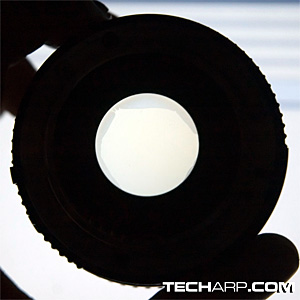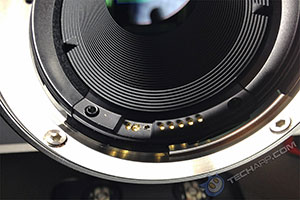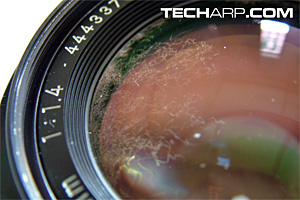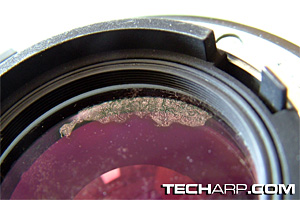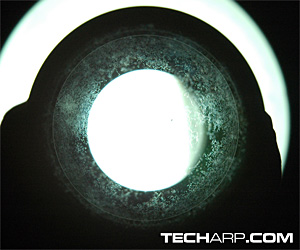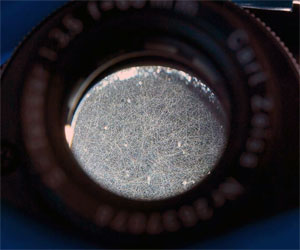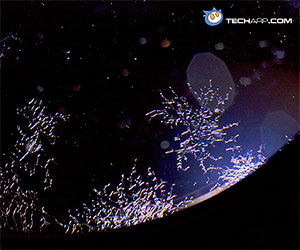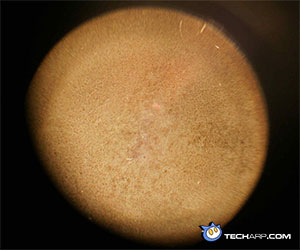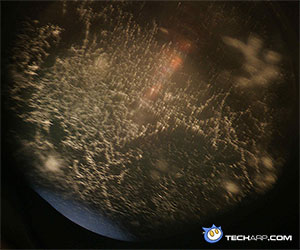Separated Lens Elements
Lens elements are held together by optical cement. In rare cases, the adhesive bond between the lens elements may fail. This results in what is known as lens element separation.
This kind of defect usually manifests as discoloured or reflective areas at the edges of the elements, but can also appear in the form of bubbles.
In mild cases, there is little effect on the image quality especially if it only involves the edge. However, a severely separated lens usually results in poor image quality.
To check for lens element separation, look through the lens at a bright light source. The bright sky or a sun-lit wall works well. By varying the distance of the lens from your eyes, you can focus on the different elements in the lens and look for element separation.
If you notice bubbles or patches of discolouration, you should not buy the lens. Repairing it will cost you quite a lot of money because the lens has to be dismantled, the old cement removed and the elements recemented. It is generally not worth repairing such a lens unless it is very valuable or rare.
Loose Lens Elements
Some used lenses may have loose elements. These lenses will rattle
when you shake them. Just don't shake them too vigorously! ![]()
A single loose element will generally not cause any issues since alignment is still maintained within the barrel. However, if a lens group or several elements come loose, you may find that it is impossible to auto-focus or focus to infinity.
You can check by trying out the lens with your camera. Try focusing on various objects at different zoom lengths (if it's a zoom lens). You should also try focusing on something far away, like the sky or a distant building. If the lens hunts around and cannot lock focus, then it's a significant problem.
Even with this problem, you can consider buying the lens if the seller is willing to offer it to you at a low price. You can get it serviced and repaired by a technician for relatively little cost.
Damaged Contacts
This is a rare problem that may occur if the previous owner used the lens with a third-party adaptor, like this example on the right, which occured from the use of an EF mount for the Blackmagic Cinema (BMC) camera. The tight BMC mount apparently grated off two of the EF len's contacts.
Damaged contacts can render the lens unusable, or disable some of its functionality, because they prevent the lens from communicating properly with the camera.
If you notice that any of the lens contacts are scored, chipped off, or damaged in any way; test the lens with your camera carefully. Check to make sure that there are no focus and exposure issues, and all of the lens' features (image stabilization, synchronization with the flash, focus limiter, etc.) work properly.
The good news is it is possible to replace bad contacts and they don't cost much. That said, if you can avoid lens with damaged contacts, that's one less repair job you have to deal with. Sellers should consider replacing damaged contacts before selling, as they give buyers a great reason to knock down the price of the lens.
Lens Fungus
This is the death knell for most lenses. It is hard to clean off and will often recur. Even if it is successfully removed, the lens elements may be irreversibly damaged. Fungi have been known to etch and blemish the glass coatings. So, even a good cleaning may not restore the lens to its original condition.
Lens fungus may escape detection for a long time because it usually starts from the inner wall of the lens barrel. Even when it infects the glass elements, it starts from the side and grows inwards with a fine mesh-like growth. Image quality will not be affected initially. In fact, unless you look closely with the aperture wide open, you may not notice it.
Eventually, the growth becomes thicker and you will start noticing reduced light entry and increased flaring. In late stages, the growth will become thick, and sharpness and exposure will be affected. The lens is now virtually useless. Although you can still get it cleaned, it is very likely that the fungus would have eaten away the coatings by now.
You can check for lens fungus by flicking the aperture pin near the rear element to keep the aperture wide open. Then shine a bright light through the lens. You can also place the lens under a bright source of light and alternately look through both ends. By varying the distance of the lens from your eyes, you can focus on the different elements in the lens and look for fungus.
Generally, if a used lens has fungus, you should not buy it. But if the owner is putting it out for sale at almost next to nothing and you are confident about getting the lens cleaned up, it may still be worth a try. Just make sure the growth is minimal.
Support Tech ARP!
If you like our work, you can help support out work by visiting our sponsors, participate in the Tech ARP Forums, or even donate to our fund. Any help you can render is greatly appreciated!
<<< Eroded Lens Coatings, Scratched Lens Elements, Chipped Lens Elements : Previous Page | Next Page : Buying Used Lens Online, Avoiding Fraud >>>
Support us by buying from Amazon.com! |
|
| Grab a FREE 30-day trial of Amazon Prime for free shipping, instant access to 40,000 movies and TV episodes and the Kindle Owners' Lending Library! | |







 Add to Reddit
Add to Reddit

